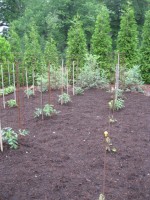 Preparing the soil for your vegetable garden is one of the most important things you can do to ensure good crops. Your plants can only reach their potential if the soil is able to give them the water and nutrients they need for good growth. The time you spend preparing the soil will pay off handsomely in the long run so look at it as an investment, the best one you can make in regard to gardening.
Preparing the soil for your vegetable garden is one of the most important things you can do to ensure good crops. Your plants can only reach their potential if the soil is able to give them the water and nutrients they need for good growth. The time you spend preparing the soil will pay off handsomely in the long run so look at it as an investment, the best one you can make in regard to gardening.
Unless you are blessed with good loamy soil that is fertile, deep, easily crumbled, high in organic matter, and well drained, don’t expect to have perfect soil quickly. Building a perfect soil for plants takes time and is never completely done but every improvement that you make helps improve plant growth and vegetable production.
Here are five guidelines for soil preparation for a vegetable garden (assuming that all shrubs, trees and other large plant material have been removed).
1. Have a soil test. Contact your local county extension office for more information. States often have free or inexpensive soil tests. This is best done in fall or winter before every other gardener in the state is sending in soil samples. This should be done every 3 years.
2. Add organic matter. The best way to improve a soil with too much clay or to much sand is to add organic matter. Add a 2-3” layer of compost, well-rotted manure, or well-rotted leaves. This can be done in fall and spring; if you want even more organic matter plant a cover crop such as winter rye, annual ryegrass, or wheat.
3. Correct the pH. A soil test is the only reliable way to know the pH of the soil and how to correct it. The ideal pH for most vegetables is between 6.0 and 6.5. If you have the state do the soil test they will tell you how to correct the pH for vegetable garden. When lime is needed, apply in fall so that soil acidity problems can be corrected by spring.
4. Turn over the soil: If the garden is small you can do this by hand but if large consider a rotary tiller or plough. You can probably rent a rotary tiller but will have to hire a local farmer with a tractor to get a plough. Turning the soil can be done in the fall, the spring, or both, depending on when you added organic matter (see item 2). Any organic matter you add should be incorporated into the soil for best effect.
5. Apply a balanced fertilizer. A soil test will indicate what your soil needs but a fertilizer such as 8-8-8 or 10-10-10 applied as indicated on the package is usually sufficient. Broadcast the fertilizer a couple of weeks before planting.
N.B. Some soils are lacking in nitrogen and some crops are heavy feeders so more nitrogen may need to be added as the season progresses, but that’s another post.
Whew! Soil preparation is not an easy task but it is a very important one and worth the effort. Yes, it should be done every year, and that means a big fall AND big spring project if you want to maximize your vegetable garden space. When the plants are growing vigorously and producing all those fresh vegetables you can stand back and bask in the glory of their productivity knowing that you are about to have a feast.
